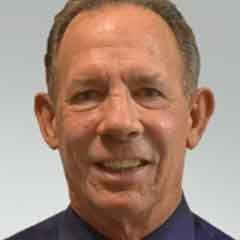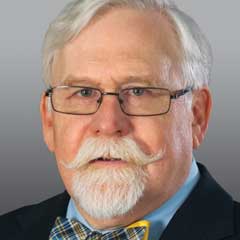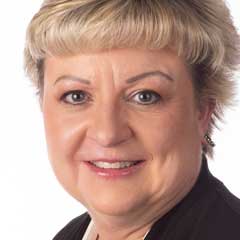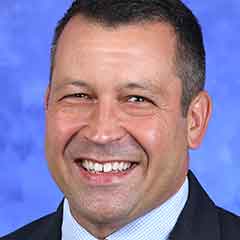Day 4 — Saturday, Nov. 23
All times are Eastern Standard Time. 3.15 CRCE available.
Display Preferences
Hide/Show
8:30 a.m.–9:05 a.m. | Ballroom WF4 | Adult Acute Care
Optimizing Patient-Ventilator Interactions
John Davies, MA, RRT, FAARC, FCCP
Show description

Inappropriate interactions between the ventilator and patient are referred to as patient–ventilator asynchrony. This is a mismatch between what the patient desires in breath and what the ventilator provides. Detecting asynchrony at the bedside requires a rigorous examination of the flow and airway pressure waveforms and a clinical examination of the patient's breathing pattern. Unfortunately, many asynchronies are treated with sedation before a thorough graphical analysis of the ventilator waveforms and clinical assessment are conducted. It is well known that the overuse of sedatives leads to a longer duration of mechanical ventilation. This lecture will explore how to identify the various asynchronies and discuss methods to optimize patient-ventilator synchrony, emphasizing using sedation as a last resort.
8:30 a.m.–9:05 a.m. | Room 224A | Education
Red Flags: Opportunities to Identify Students Who Are About to Bail
Megan Koster, EdD, RRT, RRT-NPS
Show description

Wouldn’t it be nice to have a crystal ball to help anticipate which students may be at the most risk of attrition? While waiting on the mystical arts, educators must look to the tangible tools to help identify students who may be most at risk for attrition throughout the course of their academic career. The presenter will address the top reasons students leave respiratory care programs and some opportunities to proactively address those issues to help ensure students are crossing the finish line (no crystal ball needed).
8:30 a.m.–11:20 a.m.
Symposium
Journal Symposium
8:30 a.m.–9:05 a.m. | Room 230C | Ethics
Artificial Intelligence and Medical Publishing
Richard Branson, MSc, RRT
Show description

Artificial intelligence has begun to be part and parcel of many facets of our lives and work. AI in research and medical publishing has the potential for great utility and abuse. This presentation will review the rules around the use of AI and publishing.
9:15 a.m.–9:50 a.m. | Room 230C | Education
How to Start a Journal Club in Your School or Department
Christopher Piccuito, MSEd, RRT, RRT-NPS, RRT-ACCS
Show description

Journal clubs are a tried-and-true method of teaching analysis of the published literature and growing staff knowledge on research methods. Starting a journal club can be a challenge but there are good templates for making this manageable. This presentation will review the important components of a journal club process and highlight keys to success.
10:00 a.m.–10:35 a.m. | Room 230C | Leadership & Management
How to Review an Original Research Paper
Denise Willis, MSc, RRT, RRT-NPS, AE-C, FAARC
Show description

Peer-review is the lifeblood of medical publishing. Good peer-reviews are quite frankly few and far between. To be a good reviewer one must be an avid reader and be prepared to invest time in the process. This presentation will describe a method for evaluating an original research paper.
10:45 a.m.–11:20 a.m. | Room 230C | Ethics
Social Media in Research and Publication — The Good, the Bad and the Ugly
Andrew Miller, MSc, FAARC, FCCM
Show description

Social media is both a powerful tool for disseminating research findings and a potential method of fraud and abuse. Social media is often used for self-promotion and advancing industry objectives. Social media can also help provide important evidence to a large audience and drive readers to quality peer reviewed literature. This presentation will demonstrate both positive and negative uses of social media in medical publishing.
8:30 a.m.–9:05 a.m. | Room 224C | Leadership & Management
Leadership and Social Media: How to Develop a Purposeful Brand
Edward F Garcia, MS, RRT, RCP
Show description


Explore the dynamics of leadership and social media, uncovering the advantages and disadvantages for leaders using digital platforms for branding. Gain insights on purposeful branding techniques, dos and don’ts, and real-life examples of successful branding. This talk is designed for respiratory care leaders or future leaders, offering practical strategies for leveraging social media to enhance leadership presence authentically.
8:30 a.m.–9:05 a.m. | Ballroom WF3 | Neonatal/Pediatrics
Enhancing Neonatal Pediatric Respiratory Care through Patient-Centered Care
John Blewett, MA, RRT, FAARC
Show description

Patient-family centered care should be practiced across all care continuums, specialties, and disciplines. Respiratory therapists are positioned to optimize patient outcomes by prioritizing unique Patient-family needs to develop an individualized plan of care. Patient-family centered care will be described from the lens of a respiratory therapist with a medically complex child along with published evidence to identify a path to improve patient outcomes and family and clinician experience.
8:30 a.m.–9:50 a.m. | Room 240B | General
Agency Update
Dana Evans, MHA, RRT, RRT-NPS, FACHE, FAARC — AARC President
Amy Boeckmann, MPA, RRT — NBRC President
Sarah Varekojis, PhD, RRT, RRT-ACCS, FNAP, FAARC — COARC President
Carl Hinkson, MSc, RRT, RRT-ACCS, RRT-NPS, FAARC — ARCF Chair
Show description




The leadership of the AARC, ARCF, CoARC, and NBRC will present the most updated information affecting the profession, research, accreditation, and credentialing. This is a must-attend session on your agenda!
9:15 a.m.–9:50 a.m. | Ballroom WF4 | Adult Acute Care
Lung Protective Ventilation: Set It and Forget It?
Ivan Garcia, RRT, ECMO Specialist
Show description


The evidence-based approach to lung protective ventilation has evolved with recent updates to the management of ARDS published in 2023. Though the application of these guidelines can and should be broadly applied in patients with ARDS, recent research points towards potential mechanisms of injury despite the application of these lung protective strategies as well as the possible benefits of individualizing the approach to mechanical ventilation in ARDS. Evidence for individualization of tidal volume, plateau pressure and PEEP to enhance a protocolized lung protective approach will be discussed.
9:15 a.m.–9:50 a.m. | Room 230A | Education
Microlearning — Small but Mighty
Sara Murphy, MBA, RRT, RRT-NPS, RRT-ACCS, AE-C
Show description

Microlearning delivers powerful, bite-sized education for busy healthcare professionals. This innovative approach fulfills continuing education requirements and empowers staff to master competencies and enhance patient care. By providing quick, accessible knowledge, microlearning boosts staff expertise and drives positive patient outcomes.
9:15 a.m.–9:50 a.m. | Room 224C | Clinical Practice
What Should We do When Evidence is Lacking?
Dean Hess, PhD, RRT, FAARC
Show description

Best practice calls for the use of an evidence-based approach. However, evidence is often lacking. There are gaps where high level evidence is lacking in respiratory care practice. This lecture will explore how one might address practice where the evidence is lacking.
9:15 a.m.–9:50 a.m. | Ballroom WF3 | Neonatal/Pediatrics/Sleep Medicine
Help Me Sleep!
Edward Matthews, BS, RRT, RRT-NPS, RRT-SDS
Show description

Infants and children benefit from a clinically astute respiratory therapist who knows the signs and symptoms of obstructive and central sleep apnea. Polysomnography, non-invasive ventilation, upper airway stimulation, and surgery are diagnostic and treatment strategies available. Additionally, involving the respiratory therapist in the multidisciplinary approach in the sleep clinic can help facilitate optimal treatment.
10:00 a.m.–10:35 a.m. | Ballroom WF4 | Adult Acute Care
Time or Data? Capitalizing on the Tracheostomy Tube
Brian Ring, PhD, MSc, RRT, RRT-ACCS, RRT-NPS
Show description

There is a lack of consideration for patients’ physiology when they are systematically weaned from mechanical ventilation, a process colloquially known as a trach collar trial. Often, a time-goal is applied, with periodic patient assessments conducted during the patient’s removal from the ventilator. However, a prescribed time goal may underestimate the patient's ability to be liberated from mechanical ventilation, potentially prolonging recovery. This lecture will discuss the potential use of non-invasive bedside imaging to guide the liberation of tracheostomized patients from mechanical ventilation in the intensive care setting.
10:00 a.m.–10:35 a.m. | Room 240B | DEI
Equity in Healthcare: Be Part of the Solution!
Patty DeJullio, MS, RRT, RRT-ACCS, RRT-NPS
Show description


This presentation will define equitable care by examining disparities and biases and microaggressions in healthcare. Also discussed will be ways to avoid biases and microaggressions that exist. The presentation will include case studies of inequities in patient care, as well as solutions to correct the behavior.
10:00 a.m.–10:35 a.m. | Room 230A | Education
You Never Said that Would be on the Test!
Sara Parker, RRT, RRT-ACCS, RRT-NPS, AE-C
Show description

Transparency in grading helps students understand why professors teach the way they do. Mapping course objectives to lessons deepens student understanding of the importance of assessments and holds faculty accountable for matching the stated objectives to assessments. Effectively communicating grading policies and grading criteria can enhance and improve student success and satisfaction.
10:00 a.m.–11:20 a.m.
Symposium
A Deeper Dive into Equipment for RT Leaders
10:00 a.m.–10:35 a.m. | Room 224C | Leadership & Management
The Life Cycle of Medical Equipment
Julie Jackson, BAS, RRT-ACCS, RRT, RCP
Show description

Respiratory Therapists are often inundated with new equipment but often are unaware of what occurs prior to equipment being available for the end-user. This presentation will review the prior to market steps that occur for medical equipment including design, testing, patents, FDA, and manufacturing.
10:45 a.m.–11:20 a.m. | Room 224C | Leadership & Management
Capital Equipment Management
Dana Stauffer, MS, RRT, RRT-NPS
Show description

Medical equipment is expensive and often budgetary constraints prevent unlimited purchasing. Strategic capital equipment planning is necessary for respiratory care leaders to manage respiratory equipment while balancing patient safety. This lecture will review the importance of strategic capital equipment planning, manufacture recommendations for useful life, and financial considerations in budgeting.
10:00 a.m.–10:35 a.m. | Ballroom WF3 | Neonatal/Pediatrics
Should All Neonatal CPAP Be Treated Equal?
Anne Geistkemper, MSc, RRT, RRT-NPS
Show description


Neonatal CPAP can be delivered via continuous flow or variable flow modalities. The literature identifies pros and cons of various CPAP options, crucial factors to weigh when choosing optimal support for neonates. Importantly, emphasis needs to be placed not only on selection of device and prescribed settings, but assuring that pressure delivered to the patient is adequate and monitored. What we set should be what we get!
10:45 a.m.–11:20 a.m. | Ballroom WF4 | Adult Acute Care
Individualized PEEP Titration in Patients with ARDS
PRO: Keith D. Lamb, RRT, RRT-ACCS, FAARC, FCCM
CON: Dean Hess, PhD, RRT, FAARC
Show description


Much controversy remains about the setting of PEEP in patients with ARDS. PEEP can be set based on population studies or individualized based on the use of techniques such as esophageal manometry and electrical impedance tomography. The debate will address the issues related to these approaches.
10:45 a.m.–11:20 a.m. | Room 240B | DEI
Supporting Neurodiversity with Students, Staff and Colleagues
Gabrielle Davis, MPH, MA, RRT, RRT-NPS, RRT-ACCS, TTS, LPC, NCC
Show description

While discussions surrounding neurodiversity have surged in recent years, it's essential to recognize that this diverse population has always been present. This session is crafted to acquaint leaders and educators with novel concepts, offering insights that may be unfamiliar. It aims to unveil strategies for dismantling barriers and creating opportunities, ultimately paving the way for students, staff, and colleagues to access success.
10:45 a.m.–11:20 a.m. | Room 230A | Education
Degree Advancement in RC: Barriers, Perceptions, & Incentives
Trevor Lee, MSRC, RRT
Show description


This lecture explores the role of degree advancement in both the personal and professional growth of respiratory care practitioners. The speaker will address the perceived obstacles to further education, examine the need for lifelong learning in respiratory care, and highlight the incentives—or lack thereof—that either support or hinder such advancement.
10:45 a.m.–11:20 a.m. | Ballroom WF3 | Neonatal/Pediatrics
PEEP Titration Using Electrical Impedance Tomography in Neonates
Carolyn La Vita, RRT, RRT-ACCS, RRT-NPS
Show description

Bronchopulmonary dysplasia is a common outcome for patients born prematurely. Hallmarks of BPD are increased airways resistance, impaired gas exchange, long time constants, and dynamic airway collapse. While identification of optimal PEEP can alleviate some challenges of controlled mechanical ventilation, there is no documented best way to find optimal PEEP. Utilization of Electrical Impedance tomography (EIT) to identify optimal PEEP will be discussed.
11:30 a.m.–11:50 a.m. | Tangerine Ballroom | General
AARC Closing Ceremony
Dana Evans, MHA, RRT, RRT-NPS, FACHE, FAARC — AARC President
Show description

Thank you for coming to the 2024 AARC Congress. AARC President Dana Evans will wrap-up the meeting with some closing remarks and reminders to attendees.
11:50 a.m. -12:40 p.m. | Tangerine Ballroom | Pulmonary Function/Rehabilitation
12th Thomas L Petty Memorial Lecture
Reconsidering Race and Ethnicity for Predicting Normal Lung Function
Ellen Becker, PhD, RRT, RPFT, AE-C, FAARC
Show description

Prediction equations for normal lung function commonly included a race/ethnicity variable. Recently, researchers highlighted problems resulting from the use of a social construct such as race/ethnicity to predict biological function. This presentation will help clinicians better advocate for their patients by understanding how race-neutral prediction equations impact disease severity and treatment eligibility.
Sponsored by
There are no sessions that match your display preferences.

